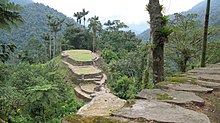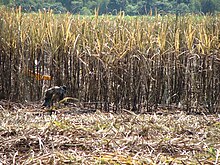Agriculture in Colombia

Agriculture in Colombia refers to all
The primary
The share of agriculture in Colombia's gross domestic product (GDP) has fallen consistently since 1945, as industry and services have expanded. However, Colombia's agricultural share of GDP decreased during the 1990s by less than in many of the world's countries at a similar level of development, even though the share of coffee in GDP diminished in a dramatic way. Agriculture has nevertheless remained an important source of employment, providing a fifth of Colombia's jobs.
History of agriculture in Colombia

Pre-Colombian agriculture
The indigenous people also were avid hunters and consumed processed local fauna, predominantly deer, rabbits, snails, fishes and birds.
Spanish conquest and colonization
With the arrival of the
During the Early 17th Century the
The latifundios were great extensions of land owned by a single or very few owners and workers lived in the hacienda solely for the production of food, while the minifundios were small pieces of land owned by peasants mestizos which overused it and unfertilized these. The indigenous population was forced out from the rural areas and into the urban villages.[3][4]
Independence
After the independence the
Agricultural policy
The most relevant policy instrument affecting the recent evolution of the agricultural sector has been the
Public policy toward the agricultural sector also has included the establishment of subsidized sources of credit. Since 1990 such mechanisms have included the Fund for the Finance of the Agricultural Sector (Finagro). Other policy instruments have included minimum price guarantees, import quotas, subsidized credits and tax exemptions, campaigns to promote consumption, incentives for new investments and for forestry plantations, and more recent exchange-rate or currency-hedging options.[5]
Production
Colombia is one of the 5 largest producers in the world of coffee, avocado and palm oil, and one of the 10 largest producers in the world of sugarcane, banana, pineapple and cocoa.[6]
Colombia produced, in 2018, 36.2 million tons of
Agricultural products
In 2006 Colombia's most important agricultural products were

Cattle
Cattle raising is the most widespread agricultural activity in Colombia, accounting for 74 percent of Colombia's agricultural land in 2005.
Nevertheless, cattle traditionally were not a particularly important or consistent net export for Colombia, and coffee's dominance within the country's agricultural exports remains largely unchallenged, although cattle is needed for milk.
Perhaps the most significant sectoral change in modern times was the creation of the
Coffee
Coffee historically has been a major factor in the Colombian economy. Although Brazil became the dominant force in coffee production and trade when the crop was introduced to South America in the eighteenth century, the uniquely rich flavor of the coffee from Colombia's newly cultivated highland regions led to its becoming a major Colombian export in the late nineteenth century. By the 1920s, coffee made up 70 percent of total exports.[9]
At its outset, the production of coffee held much promise for the nation's economy. It incentivized the development of infrastructure, fueling the construction of roads connecting areas of cultivation to the distant coasts, as well as a railway system.[9] The United States quickly became the primary consumer of Colombian coffee.[9] Furthermore, the cultivation of coffee on smaller-scale farms allowed for the growth of a robust middle class composed largely of local producers. However, the rise of larger multinational corporations such as the United Fruit Company in the twentieth century proved difficult to compete with.[9]
Since the middle of the twentieth century, however, its relative importance has been decreasing, largely as a natural outcome of the country's development process. The increase in the share of the services sector, as the nation has developed, corresponded to the reduction of coffee in both GDP and exports. Whereas in 1985 coffee exports represented 51 percent of total exports in value terms, they represented less than 6 percent in 2006. However, the relative decline in coffee's share of both GDP and exports should not imply that coffee has ceased to be a determining factor both in economic and social terms. The livelihoods of an estimated 566,000 families, some 2.3 million Colombians, depend entirely on coffee.[5]

The two most important increases in coffee's international price per pound since 1821 occurred after the signing of the Inter-American Coffee Agreement of 1940 and the International Coffee Agreement of 1963. Such real price peaks occurred in 1954 and 1978, inducing increased production, enhancing inventories, and leading eventually to lower real coffee prices.[5]
In 2003 coffee registered a price of US$0.60 per pound, its lowest price since 1821, because of the collapse of the International Coffee Agreement of 1989, the expansion of production in Vietnam, and the reallocation of production in Brazil toward the northern milder areas. Moreover, between 1999 and 2002 Colombia shifted from being the second-largest to the third-largest producer of coffee in the world, behind Brazil and Vietnam.[5]
These developments in international markets mean that since 2002 Colombia has restructured the institutional management of coffee. There have been significant changes at the

Flowers
Cut-flower production represented 4.2 percent of agricultural GDP in Colombia in 2006, generating 94,000 direct jobs and 80,000 indirect jobs, and it is estimated that about 1 million Colombians depend on income generated by the growth of flowers. Women account for 60 percent of the workers in the flower industry, and their terms of employment are favorable in light of Colombia's overall labor markets. Nevertheless, working conditions, which may include exposure to
The flower sector is an example of Colombian entrepreneurship in international markets, with little government involvement. Colombia has long been the second-largest cut-flower exporter in the world, behind the Netherlands, and continues to be the largest flower exporter to the United States. Colombia's flower exports in 2004 amounted to US$704 million, making flowers the country's second most valuable legal agricultural export, behind coffee and ahead of bananas and sugar. After the United States, which receives 82 percent of Colombia's flower exports, the second-largest market for Colombia's flowers is the European Union (EU), with 9 percent.[5]
The Colombian Association of Flower Exporters (Asociación Colombiana de Exportadores de Flores, or Asocolflores) represents Colombian flower producers and exporters on trade policy and legal issues, mainly with the policy makers of Colombia, the United States, and the EU. Asocolflores also addresses sectoral issues, such as transportation, market intelligence, and R&D.[5]
Bananas
Colombian bananas (excluding plantains) are another export success story of Colombia's agriculture. Despite the violence that has long affected the producing regions, banana exports, which amounted to about US$525 million in 2006, are the third-largest legal agricultural export of the country, behind coffee and flowers. In 2005 Colombia was the tenth-largest producer, with 2.5 percent of the world's banana output, and the third-largest exporter, with 8 percent of the world's exports after
The main destination of Colombia's banana exports is the EU, and the second is the United States. Given the importance of the EU's banana market for Colombia and for Latin America, the outcome of the continuing disputes at the World Trade Organization (WTO) with regard to quotas and tariffs is a major issue to this sector. In November 2007, the WTO ruled against the dramatically increased duties imposed by the EU on its imports of Colombian bananas in January 2006.[5]
About 9 percent of Colombia's banana output is destined for the domestic market, and 70 percent of this production is located mainly in the departments of Valle del Cauca and Tolima. Production for domestic consumption is not as sophisticated in technological terms as that for export markets. Producers and exporters are organized in several associations, of which the best known is the Association of Colombian Banana Producers (Asociación de Bananeros de Colombia, or Augura). Plantains are less important than bananas as a Colombian export but have a larger output share, representing 5.2 percent of agricultural GDP in 2006.[5]
Sugar
Sugar production, which represented 2.5 percent of agricultural GDP in 2004, is concentrated in Valle del Cauca Department and is based on

The domestic market is highly protected through the Andean Price-Band System; domestic prices are therefore higher than international prices, which has hurt consumers and producers using sugar as an input. In order to avoid extra sugar costs for the domestic confectionery industry competing in the international markets, a joint program between domestic confectioners and the sugar producers began in 1993, allowing the confectionery firms access to sugar inputs for its exports at more competitive prices.[5]
About half of Colombia's sugar output is exported, one quarter is used for domestic consumption, and the rest is sold as an input to the industrial sector. Colombia is the seventh-largest exporter of raw sugar in the world and the fifth-largest exporter of refined sugar, with exports of US$369 million in 2006. The main export destinations for Colombian sugar are the Andean countries, the United States, and Russia.[5]
Government policies aimed at lowering dependence on
Thirteen of the 14 Colombian sugar mills are members, along with a group of sugarcane producers, of the Association of Sugarcane Growers (Asociación de Cultivadores de Caña de Azúcar de Colombia, or Asocaña), an influential business group. The Colombian Association of Sugarcane Producers and Suppliers (Asociación Colombiana de Productores y Proveedores de Caña de Azúcar, or Procaña) also represents sugarcane producers, and the Sugarcane Research Center of Colombia (Centro de Investigación de la Caña de Azúcar de Colombia, or Cenicaña) has made a positive contribution to Colombia's sugarcane productivity.[5]

Palm oil
Output of palm oil tripled between 1990 and 2006, putting Colombia among the world's top five producing countries and making the country the largest producer in the Americas, although with a world-market share of only 2 percent in 2006. Production of palm oil is expected to increase further because it is an important component in Colombia's
Labor Practices
In 2014, the
See also
References
- ^ (in Spanish) En Colombia: Historia de los Humedales en Bogota; La Dieta Muisca y los Humedales Archived February 17, 2012, at the Wayback Machine encolombia.com Accessed 19 September 2007.
- ^ Medical Marijuana on Agricultural Lands Discussion
- ^ a b c d Workmall: Colombia; The Colonial Economy - Source: The Library of Congress Country Studies workmall.com Accessed 20 September 2007.
- ^ a b c (in Spanish) Monografias: Agricultura y capitalismo en Colombia. La interpretación de las relaciones precapitalistas en las actividades agrícolas (1890-1983) monografias.com Accessed 20 September 2007.
- ^ a b c d e f g h i j k l m n o p q r s t u Roberto Steiner and Hernán Vallejo. "Agriculture". In Colombia: A Country Study (Rex A. Hudson, ed.). Library of Congress Federal Research Division (2010).
 This article incorporates text from this source, which is in the public domain.
This article incorporates text from this source, which is in the public domain.
- ^ Producción de Colombia en 2018, por la FAO
- ^ What is the best coffee? Brazilian or Colombian?
- ^ Colombia production in 2018, by FAO
- ^ ISBN 978-1-118-77250-8.
- ^ "2013 Findings on the Worst Forms of Child Labor -Colombia-". Archived from the original on 2016-04-20. Retrieved 2015-02-01.
- ^ List of Goods Produced by Child Labor or Forced Labor

